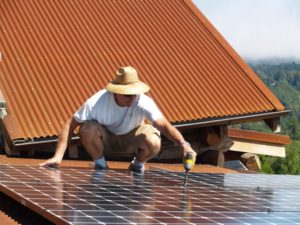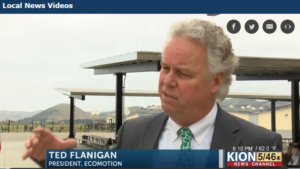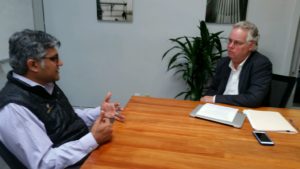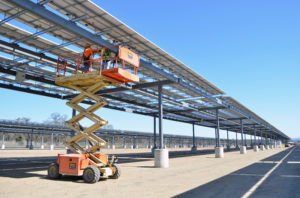May 2018 – Volume 20, Issue 4
In This Issue
Flanigan’s Eco-Logic
Quote of the Week
Twin Tunneling Under the Delta
2018 LABC Sustainability Summit Notes
California Mandates Solar for New Homes
EcoMotion Highlights
Solar Jobs Report
Batteries, Cobalt, and the Solar/Hydrogen Economy
Electric Garbage Trucks

Flanigan’s Eco-Logic: Collective Vision and Flying Taxis
Years ago, I sat on a British Airways jet headed for Moscow. It was 1988. Seated beside me was a woman of Indian descent. We and many others on the plane were headed to the Global Forum on Sustainable Development of the World’s Spiritual and Parliamentary leaders. We were excited to meet and chatted freely. The greatest environmental problem? Population? No, she insisted, the more people on the planet the greater collective vision we’ll have.
I hope she is right, that the-more-the-merrier on this planet. One thing is for sure, the pace of innovation seems to beat faster and faster… a function of more good minds, as well as diet. There is no hallowed ground. Every industry, every standard practice is ripe for change and is not spared. Change is big and small but everywhere and fast. Community choice aggregation is ripping through the utility industry, providing a potent option for millions of consumers when before there was none. Skylights are now being coupled with whole house fans. Taxis have been largely replaced with Uber and Lyft… and now taxi cabs that ply our nation’s streets may soon be overwhelmed by the third spatial dimension!
Yifang (Derrick) Ziong, co-founder and CMO of EHang, Inc. appeared on stage at the Los Angeles Business Council Sustainability Summit in April ala Steve Jobs… simple t-shirt, casual, matter-of-fact kind of talk and style. His presentation: Creating a Three-Dimensional Transportation System with Drones. Derrick began with two images, one looking down at Earth’s sprawl of civilization, traffic jams, and congestion. The second, a look up at the blue, uncongested sky. “We’ve got to look up for solutions,” he surmised.
Derrick founded EHang in Guangzhou, China in 2014. The company’s signature product has been drone swarm formation flight. He showed pictures of vast formations of drones in flight, masterfully programmed to create all manner of formations. Then his firm began to focus on taxis, known in the industry as Autonomous Aerial Vehicles (AAVs). Derrick logically dismisses pilots when hundreds of drones can be controlled at a terrestrial, central control center, just like the swarms he’s controlled.
EHang prototypes have been built and tested. Derrick boasts that the Ehang 184 AAV is the safest, smartest, eco-friendly, low-altitude autonomous aerial vehicle available. His drones have lots of built-in redundancy… using eight independent motors with 16 blades on its dual-passenger model. Derrick shows a video of himself in flight. EHang’s drones have even been tested in the fierce winds of the Asian monsoon seasons. He talks with pride about a recent flight test with a Dutch prince.
The pace of innovation continues to beat ever faster. Creativity in music, theater, the arts, in engineering, social media, is dizzying. Disruptions to technologies and services is now the norm. Cell phones have replaced land lines. Newspapers and travel agents are things of the past. Uber is having to re-tool and to adapt as it shifts from fledgling good energy, to a more mature business model in need of quality control. My car is an internet hot spot and recently needed a software upgrade.
It’s hard for me to imagine autonomous cars, being comfortable at the mercy of a computer. It’s even harder to imagine an autonomous drone taxi flying high above the congested streets, zooming unfettered over Earth’s maize and congestion. But don’t close your eyes for too long, don’t insist on being comfortable or prescient, or the industry that you ply may be radically different, even indistinguishable, in the very near future.
Quote of the Week
“We cannot let Californians be in homes that are essentially the residential equivalent of gas-guzzlers.”
– David Hochschild, CEC Commissioner on California’s solar mandate for new homes
Twin Tunneling Under the Delta

Source: CaliforniaWaterFix.com
On April 10th, the Metropolitan Water District of Southern California’s board elected to support a massive Delta “water fix” by authorizing the construction of twin tunnels that will burrow under Sacramento-San Joaquin River Delta to bring water to Southern California. Despite dissenting votes by cities including Los Angeles, San Diego, and Santa Monica, MWD committed to spend $10.7 billion, 65% of the total project cost. Considered vital to Southern California, the project will sustain water deliveries that make up a third of Southern California’s water supply.
Two, 35-mile tunnels are the root of a project known as California WaterFix. Its purpose is to maintain water deliveries to the San Joaquin Valley and to Southern California cities despite conditions in the Delta. MWD serves water to half of California’s population. Different regions called for different versions of the project. The City of Los Angeles wanted to delay the project and to study alternatives. A less expensive single-tunnel version was advocated by some members; Ventura, Orange and inland counties preferred two tunnels.
It’s not yet a done deal. MWD’s vote does not assure that the tunnels will be built. The project needs permits; there will likely be challenges from opponents, such as those who favor storm-water capture and recycling solutions. At best, water will be conveyed through WaterFix in 2034.
2018 LABC Sustainability Summit Notes
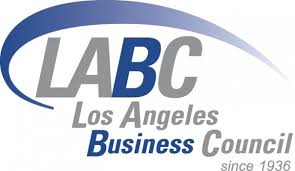
For 12 years the Los Angeles Business Council (LABC) has been hosting an annual sustainability summit, for the past several years drawing more than 1,500 in person and via live stream. LABC advocates business-driven solutions and effective public policy. The summit was at the Getty.
These are power-packed events with an impressive roster of speakers. This year’s theme was “Regional Solutions for an Inclusive, Clean Economy.” Participants lapped up the greenest rhetoric: “We’re doubling down… Washington will not slow our progress.” I was struck by CSUN’s Institute for Sustainability founded in 2009, its integrated vision and practice (California State University at Northridge); I was impressed by Renew Financial’s 90,000-home track record with PACE financing.
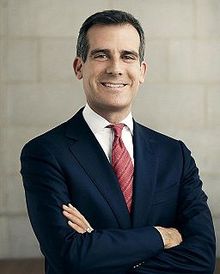
Eric Garcetti
Then I found myself “regionally inspired” by the governors of Oregon and Washington, and Los Angeles’s Mayor Eric Garcetti. The Pacific Coast Collaborative made up of California, Oregon, Washington, and British Columbia is a model of green success, an international leader clearly busting the notion that going green is hard on the economy. The Collaborative encompasses a population of more than 55 million people and a combined gross domestic product (GDP) of $3 trillion, equivalent to the world’s 5th largest economy.
The region has taken bold green steps: British Columbia is home of the carbon tax; California has cap and trade, both aggressive means to monetize and reel in emissions. Washington Governor Jay Inslee promised that the Trump administration’s retrenchment of environmental reforms will be “nothing but a blip on the history of sustainability”.
Our three-state region’s economy has expanded by an average of 32% in eight years, not despite, but as a function of an aggressive transition to clean power. The region is well ahead of the rest of the nation – just as carbon emissions are down, also well ahead of most of the nation. The region is embracing sustainability and its economic benefits. More than a half million Californians are employed in clean energy. The region has twice the clean power than the national average.
The path to sustainability that all participants envision will not be without challenge. David Wright, General Manager of Los Angeles Department of Water and Power, projects that ubiquitous use of electric vehicles will cause the City’s power requirement to increase by 50%. All the while, his utility is analyzing how to concurrently ramp up to 100% clean power.

Emile Haddad, Chairman and CEO of FivePoint Holdings spoke of changing times and priorities, and notably what his firm had to do to develop 21,500 homes in the Newhall Ranch area of Santa Clarita. He never imagined that in order to build, he’d have to own a forest in Central America, to provide energy efficiency retrofits to inner-city schools, and to protect vast areas of open space – larger than New York’s Central Park and Los Angeles’s Griffith Park combined. Imagine net-zero Newhall. The times they are a’changing.
The early days of cell phones, remember those plans? Weekend minutes, peak minutes, horrendous texting fees? Today, there’s unlimited calling. Even international calls are bundled into rate plans. Will electricity follow suit? Perhaps we won’t pay for kWh. Just like phones that now have unlimited calling we may well shortly experience unlimited use of energy.
This concept was presented by Paul Jennings of PCS Energy. His firm is the largest participant in the Los Angeles solar feed-in tariff. Why is he investing in so much solar? The market is highly dynamic. Jennings is expecting dramatic gains in solar efficiency. Once his firm has installed solar systems, he can easily upgrade panels to boost system output and profitability.
Remarkable to me is how respected and prominent the environmental justice issues of the day are. Not only is California and the Pacific region leading the climate protection charge, but there’s a new element added to the challenge: To be really green, even if you are carbon neutral, sustainability must be equitable. Kevin de Leon gave a passionate speech, a super-articulate man he is, about this tough but critical challenge that we all face. The notion of electric utility rebates for used EVs was mentioned.
Time to leave. By mid-afternoon I was done, fulfilled by the summit. So off I went, down the tram, into my own solar-powered EV, heading to my net zero electric home. Thanks to LABC and Summit participants for the inspiration.
California Mandates Solar for New Homes
The California Energy Commission voted in May to mandate that new homes and residential units up to three stories high in California must have solar panels by 2020. California is the first state in the nation to roll out such a mandate. Some say it may be the biggest deal for the solar industry since Germany introduced its seminal feed-in tariff in 2004. Some solar stocks rose instantly. Many agree that the mandate may be the simplest, the most logical policy to wean the Golden State off fossil fuels. The new standards require not only solar but also increased insulation, air filters, and energy efficiency.
The solar mandate for new homes is part of the California Energy Commission’s triennial update of its wide-ranging energy efficiency standards. The CEC got little attention for updating its energy-saving standards for spas despite the fact that California is home to more than a million spas and that the new spa standard will save the equivalent power use of 30,000 homes. But solar stole the show this time.
The 2019 building energy efficiency update is expected to add $9,500 to the cost of an average home, while creating projected savings of $19,000 over 30 years. Concerns about the regressive nature of the mandate were presented, and housing affordability was of concern, nonetheless the new standard’s cost will increase a typical monthly mortgage by $40 while reducing utility costs by $80 a month. Homes with the new standards will use 50% of the energy used by homes built to the 2016 standards without solar.
The solar mandate originated in 2007 when the California Energy Commission adopted a goal of all new homes being net zero by 2020 as part of its “big and bold initiatives.” Seven cities in the State already have solar mandates in varying forms. San Francisco is the largest of these; Santa Monica and Palm Springs were cities that EcoMotion helped institute new construction solar mandates. California’s new mandate includes compliance credits for batteries.
So, what will the direct impact of the mandate be? Housing turns over in California at a rate of about 1% per year. California’s new home construction peaked in 2004 at 200,000 units. The level fell to 113,000 units last year. This compares with 127,000 residential PV systems installed in California last year. The CEC notes that incorporating solar in new construction is cheaper than installing solar on existing homes, at least a $0.50/watt savings… largely due to a blissful lack of customer interaction!
The rooftop solar systems required under Title 24 must be sized with annual electrical output equal to or greater than the dwelling’s annual electricity usage as determined by an equation specified in the code. They must be net zero electric to be precise. Sierra Club noted that homes built to the code will not be net zero energy since natural gas usage is not included. California homes use as much natural gas as is burned in California power plants.
The new mandate will require that the average solar system size across California’s 16 climate regions will be 3.38 kW. It will take 2.7 kW to meet the standard in San Diego; at least 5.7 kW in Palm Springs. In the event that a building is not suitable for a rooftop array, the standard requires homes have access to community solar or offset energy usage through additional efficiency gains.
EcoMotion Highlights
EcoMotion celebrated EarthDay 2018 at the Los Angeles Leadership Primary Academy (LALA) on Monday, April 22. Emissions Time Bomb served as the focal point of two student assemblies. At each assembly, EcoMotion presented the climate science, and then focused on simple steps that students can take to alleviate climate change. The rally stressed a) the enormity of the climate challenge, and b) the imperative for each of us to take simple steps to “Save a Ton.” Each student received a pledge card to save a ton.
On May 14th, EcoMotion presided over the ribbon-cutting ceremony for the nation’s first solar-powered PERCs, Powered Emergency Response Centers. The PERCs developed by EcoMotion for the Santa Rita Union School District provide deep levels of energy resilience on campuses. Solar and storage and controls technologies allow each of six campuses to become microgrids, able to “island” from the grid in the event of a grid outage. During prolonged outages, the sites will be energized as PERCs and will serve community needs for first responders, cell phone charging, etc.
On April 24th EcoMotion recorded a podcast with Jigar Shah at his San Francisco office. Shah talked about developing the Power Purchase Agreement model and about financing innovation, notably related to EcoMotion’s PERCs in Salinas that he financed, that effectively blend solar and storage and controls to create energy resilience. Shah also reflects on his career, balance, and lessons learned. The half-hour podcast was produced by EcoMotion’s longstanding video partner — Versatile Productions – in a three-camera shoot.
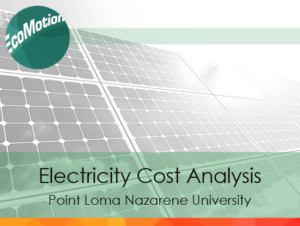 For Point Loma Nazarene University in San Diego, EcoMotion has completed a detailed electricity cost analysis. The purpose of the work was to determine if the University’s electricity bills and total cost are in order. With 144 electricity meters, 40 direct access accounts, and two different solar power purchase agreements, the analysis was robust. Overall, and thanks to attractive direct access contracts, and despite PPA prices that are “upside down,” the University is saving money.
For Point Loma Nazarene University in San Diego, EcoMotion has completed a detailed electricity cost analysis. The purpose of the work was to determine if the University’s electricity bills and total cost are in order. With 144 electricity meters, 40 direct access accounts, and two different solar power purchase agreements, the analysis was robust. Overall, and thanks to attractive direct access contracts, and despite PPA prices that are “upside down,” the University is saving money.Solar Jobs Report
The National Solar Jobs Census prepared by the Solar Foundation reports that a quarter million Americans now spend at least half of their working time in the solar industry. Fully 89% of those are working full-time in the industry.
A second study takes a second look at solar jobs. The Energy Future Initiative (EFI) is headed up for former U.S. Secretary of Energy Ernest Moniz. His organization’s research builds on the Solar Foundation research: EFI’s analysis reveals that the solar industry in America employs another 100,000 workers that work less than 50% of the time, making the total 350,000, more than the coal and nuclear industries combined.
There are 224,00 workers supported by the coal industry stretching from mining through electricity generation and including business and professional services and coal-related manufacturing. Another 74,000 workers toil in the nuclear industry including 9,000 in uranium mining and other nuclear fuel-related occupations. The grand total for coal and nuclear is 298,000 workers, 52,000 less than solar. (The largest energy employer in the U.S. is natural gas with 429,000 workers, a sector riding a two-decade boom.)
What’s interesting is that coal and nuclear provide about half the nation’s power, while solar provides less than 2%. Furthermore, the coal and nuclear employment numbers represent workers keeping existing capacity generation operational. With solar, the work is largely in the manufacture and deployment of the technology, after which it bears requires little labor and maintenance. Christian Roselund noted in PV Magazine that, “the real political power is increasingly not coming from fuels that come from the ground, but from the abundance that falls from the sky.”
Electric Garbage Trucks
Forbes said it well: “… one of the biggest, nastiest and loudest vehicles – offering the greatest potential for improvement – is your unfriendly neighborhood garbage truck.” These “belching beasts” stop every 20 yards to pick up trash. They typically travel 130 miles a day with 1,000 hard stops, full throttle and then full brakes 1,000 times a day. Most garbage trucks need to replace their brakes four times a year.
Volvo will begin manufacturing its FL Electric trucks in 2019. One of its first trucks will be used for garbage collection. It is designed for urban conditions with a 185 kW electric motor, up to 300 kWh of battery storage, and a range up to 300 miles. Volvo Trucks based in Gothenburg now joins its sister company Volvo Buses in electrification. Volvo Buses has produced over 4,000 electric buses thus far.
Ian Wright, one of the co-founders of Tesla, believes that Class 8 garbage trucks represent a “soft target for electrification” because the benefits are so great. His company, Wrightspeed, is in the business of retrofitting garbage trucks and is building a factory in Alameda, California. His design features “high power regenerative braking,” up to 730 kW. Plus, his trucks won’t wake you up in the morning!

